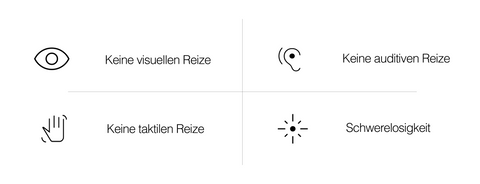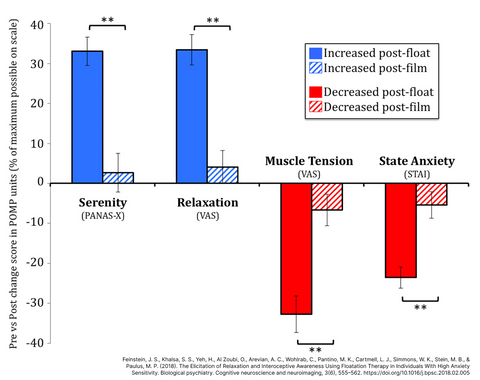Floating in science
The effect of floating
To get you started, here is a study by Feinstein et al. It examines the effects of floating on people who cannot fully participate in everyday life due to anxiety.
The results are impressive: Floating not only leads to a significant reduction in muscle tension and anxiety in the severely restricted patients (represented by the red bars), but also to a simultaneous increase in calmness and relaxation (represented by the blue bars). A unique combination with which floating actively treats and at the same time acts as a comprehensive form of mental wellness .
What happens when we don’t perceive any stimuli?
Under the term REST therapy, science is increasingly studying the effects of the protected floating environment on our bodies. Floatation-REST stands for "Restricted Environmental Stimulation Therapy" and refers to the absence of external stimuli in the body-warm salt pool. While floating, the body does not have to process any external stimuli. It is dark, our ears do not perceive any noise and our skin, the largest organ in the body, is not stimulated . This is because the brine in the pool is heated to exactly the same temperature as the outside body. This means that we do not have to compensate for temperature differences and can hardly distinguish whether we are lying in the water or on the water. The high density enables us to float on the surface of the water and at the same time ensures a unique relief for our muscles and joints . A state that relaxes the head and body in a completely natural way and provides profound relaxation.
Results of science
Leading studies come primarily from the USA and Sweden . In the low-stimulus environment, there is an increase in mental resilience and creativity , a reduction in muscular tension , positive effects on skin diseases , an alleviation of depression and anxiety, and an improvement in sleep quality . The result is active stress reduction and regeneration . Floating thus offers a widely accessible form of relaxation that meets the demands of our modern times.
From evidence to application
The uniqueness of floating lies in its impressive effectiveness and ease of use. Elite units such as the US Navy Seals, for example, integrate floating into their training in order to shorten the learning of foreign languages from six months to just six weeks. Floating puts the body in an optimal state that allows the ability to speak to be addressed through targeted auditory and visual input. In the American Football League (NFL), floating is used for regeneration and visualization of movement sequences . Dr. Justin Feinstein, a neuropsychologist at the Laureate Institute for Brain Research, researches and treats people with severe anxiety and trauma using floating.

Floating in science
Below are some of the main research areas in which floating is being investigatedFloating can effectively relieve pain caused by a variety of conditions, including chronic tension headaches, stress-related muscle tension, and whiplash.
Floating has been found to have several physiological effects that indicate reduced sympathetic arousal, such as reduced blood pressure, slowed respiratory rate, and reduced cortisol levels.
Floating may improve certain components (e.g. accuracy, precision) of athletic performance and recovery, especially when used in conjunction with guided imaging tasks. Read our blog post on this topic.
Floating reduces stress levels in both clinical and non-clinical participants.
In both healthy and sick participants, floating has been found to have positive effects on several psychological outcomes, including improved mood and reduced anxiety and depression.
Floating has been found to promote certain facets of creativity, such as originality, divergent thinking, and technical musical ability.
In participants with a wide range of anxiety disorders, floating has a significant anti-anxiety effect.


